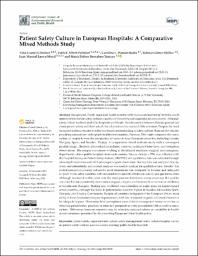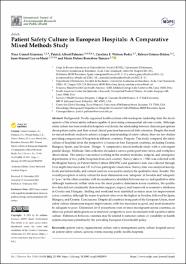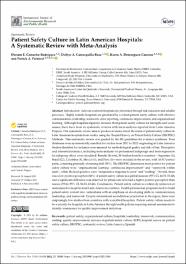Mostrar el registro sencillo del ítem
Patient Safety Culture in European Hospitals: A ComparativeMixed Methods Study
| dc.contributor.author | Granel-Giménez, Nina | es_ES |
| dc.contributor.author | Palmieri, Patrick Albert | es_ES |
| dc.contributor.author | Watson-Badia, Carolina E. | es_ES |
| dc.contributor.author | Gómez-Ibáñez, Rebeca | es_ES |
| dc.contributor.author | Leyva-Moral, Juan Manuel | es_ES |
| dc.contributor.author | Bernabeu-Tamayo, María Dolors | es_ES |
| dc.date.accessioned | 2022-10-06T21:43:59Z | |
| dc.date.available | 2022-10-06T21:43:59Z | |
| dc.date.issued | 2022-01-14 | |
| dc.identifier.uri | https://hdl.handle.net/20.500.13053/6847 | |
| dc.description.abstract | Background: Poorly organized health systems with inadequate leadership limit the devel-opment of the robust safety cultures capable of preventing consequential adverse events. Althoughsafety culture has been studied in hospitals worldwide, the relationship between clinician perceptionsabout patient safety and their actual clinical practices has received little attention. Despite the needfor mixed methods studies to achieve a deeper understanding of safety culture, there are few studiesproviding comparisons of hospitals in different countries. Purpose: This study compared the safetyculture of hospitals from the perspective of nurses in four European countries, including Croatia,Hungary, Spain, and Sweden. Design: A comparative mixed methods study with a convergentparallel design. Methods: Data collection included a survey, participant interviews, and workplaceobservations. The sample was nurses working in the internal medicine, surgical, and emergencydepartments of two public hospitals from each country. Survey data (n= 538) was collected withthe Hospital Survey on Patient Safety Culture (HSOPSC) and qualitative date was collected through24 in-depth interviews and 147 h of non-participant observation. Survey data was analyzed descrip-tively and inferentially, and content analysis was used to analyze the qualitative data. Results: Theoverall perception of safety culture for most dimensions was ‘adequate’ in Sweden and ‘adequate’to ‘poor’ in the other countries with inconsistencies identified between survey and qualitative data.Although teamwork within units was the most positive dimension across countries, the qualita-tive data did not consistently demonstrate support, respect, and teamwork as normative attributesin Croatia and Hungary. Staffing and workload were identified as major areas for improvementacross countries, although the nurse-to-patient ratios were the highest in Sweden, followed by Spain,Hungary, and Croatia. Conclusions: Despite all countries being part of the European Union, mostsafety culture dimensions require improvement, with few measured as good, and most deemed tobe adequate to poor. Dimension level perceptions were at times incongruent across countries, asobserved patient safety practices or interview perspectives were inconsistent with a positive safetyculture. Differences between countries may be related to national culture or variability in healthsystem structures permitted by the prevailing European Union health policy. | es_ES |
| dc.format | application/pdf | es_ES |
| dc.language.iso | eng | es_ES |
| dc.publisher | MDPI | es_ES |
| dc.rights | info:eu-repo/semantics/openAccess | es_ES |
| dc.rights.uri | https://creativecommons.org/licenses/by/4.0/ | es_ES |
| dc.subject | patient safety; organizational culture; safety management; safety culture; hospital surveyon patient safety culture; adverse events; nursing; public health; hospitals | es_ES |
| dc.title | Patient Safety Culture in European Hospitals: A ComparativeMixed Methods Study | es_ES |
| dc.type | info:eu-repo/semantics/article | es_ES |
| dc.identifier.doi | https://doi.org/10.3390/ijerph19020939 | es_ES |
| dc.type.version | info:eu-repo/semantics/publishedVersion | es_ES |
| dc.publisher.country | CH | es_ES |
| dc.subject.ocde | http://purl.org/pe-repo/ocde/ford#3.03.00 | es_ES |
Ficheros en el ítem
Este ítem aparece en la(s) siguiente(s) colección(es)
-
SCOPUS [380]





